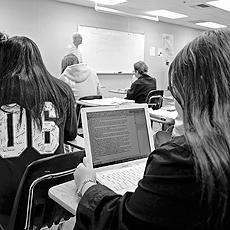Harold Goldstein
You get settled into your seat and ready your notebook for the teacher’s lecture. As the teacher begins her speech, the classmate beside you turns on his laptop and begins clicking away at the keyboard.
With frustration and curiosity, you look over to the screen to see a neighbor typing down the teacher’s words but twice as fast as you can scrawl. You glance back at your scrawny notebook paper and wonder: would it be easier to take notes on a laptop?
“I think it’s wonderful,” said Philip Stein, chair of the anthropological & geographical sciences and professor of anthropology. “I wish I had one when I was in school.”
No matter where at Pierce College, you will find a piece of technology being used by a student. The popular ones are iPods, cell phones, Blackberries and PlayStation Portables. Rarely are laptops seen on campus and why should there be?
The Learning Center is full of computers for anyone’s educational needs including a handful at the library and a few at the Freudian Sip, not to mention others that are scattered around the campus.
So why the need for laptops in classrooms?
Many teachers do not approve of laptops or other technological doo-dads being used during class time. There are many who keep policies forbidding the use of laptops in their classrooms.
“During exams, they’re not allowed to use [laptops],” says Dr. Pam Brown, political science and economics instructor. “Otherwise, they’re free to use them [to take notes in class].”
Though laptops are seldom used in Pierce classrooms, teachers might find reasonable uses for them such as e-mailing homework assignments, pop quizzes or daily notes about the subject material. Those notes could then be subject to a document production service like that used by many law firms to quickly transform any notes into professional, well-presented and correctly formatted documents.
“I think it’s a great note-taking technique,” says Stein, “and it’ll be good for future capabilities like giving assignments in class.”
Since technology has become more accessible and user-friendly for consumers, ideas have sprung of placing college-based laptops in classrooms but security may be a problem.
“Yes, there have been some thought about the opportunity [of putting laptops in classrooms],” said Larry Eisenberg, a member of the Facilities and Planning Development office at the Los Angeles Community College District. “There’ve been some issues of putting security mechanisms in the laptops. One idea has been security cards being placed in the laptops and depositing them back to the instructor after class.”
If financially feasible, laptops could be placed in classrooms for a much more benefiting experience with the lesson material. According to LACCD, laptops for the use in college classrooms would cost up to $6,000-7,000 and security measures, like the cards, would cost $3,000.
“I think it would be enormously helpful because it’s energy-saving, it saves time and it’s better for notes instead of copying everything that’s on the board [in a paper notebook],” said Brown.
Though there are many who favor the idea of classroom laptops, there are some teachers who are skeptical of it.
“If it helps them with the lecture,” says Barbara Stites, adjunct instructor of history, “[then] I encourage students to come to class with a laptop.”
Many students do enjoy the idea of having laptops in classrooms and few are rarely bothered by it.
“I don’t think [laptops are distracting] so I wouldn’t understand it being a problem,” said freshman Britney Wilson.
There are some students who are skeptical of having laptops in classrooms as well.
“It’s a distraction if you have an Internet connection,” says sophomore Minahil Mushtaq. “But it’s good because you can have your notes organized.”
Another useful tool that has popped up in the educational world is the use of wireless calculator-type devices called clickers.
Clickers, or wireless personal response systems as they are originally called, calculator-type devices that fits the palm of a student’s hand. On each individual clicker, there is a unique ID number situated for the owner. Like a calculator, they are very simple and easy to use.
Once a button is pressed on the clicker, the signal will travel to a small electronic receiver situated on a desk or wall in the classroom. The receiver will then bounce the signal to the designated computer, which will then tally each of the student’s answers and track the results.
Though the clickers are very popular, more than 800 schools have bought clickers for their classrooms and rival clicker companies have sold more than 500,000 to 1.5 million clickers, the price tag for students to buy them are from $5-50 but there are campuses that give them out for free to certain classrooms according to the Los Angeles Times.
“Not many spaces will have that type of capability,” said Eisenberg. “[But] we’ve been working on technology standards in classrooms.”
Technology has grown dramatically during this newfound digital age and education has the capability to change in a major way because of it.
“I foresee a time when students can download charts or materials from the instructor [right in the classroom],” says Stein.

()
